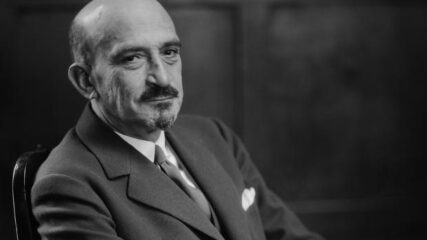Assembled here are key sources that have shaped the modern Middle East, Zionism and Israel. We have included items that give texture, perspective and opinion to historical context. Many of these sources are mentioned in the Era summaries and contain explanatory introductions.

The last of 23 volumes of Chaim Weizmann’s Letters summarized wonderfully by Aaron Klieman, recalls the Israeli first president’s views of those fateful years for Zionism and Israel from 1947-1952. Chaim Weizmann died at his home in Rehovot on 9 November 1952, shortly before his 78th birthday. All of the letters read together, provide ring side seat to Zionism as an idea to the reality of the Jewish state.

Edited by Leonard Stein in collaboration with Gedalia Yogev, London, Oxford University Press, 1968 [Reprinted with express permission from the Weizmann Archives, Rehovot, Israel, by the Center for Israel Education.] The purpose of the work commencing with…

The biographies listed from Chaim Weizmann’s papers are those individuals with whom he corresponded from the 1870s to 1951. The list includes Americans, Europeans, Zionists and British officials. Each biography is extensive, including affiliation, career high points and other valuable information not usually available elsewhere.

The Letters and Papers of Chaim Weizmann Summer 1885 – 29 October 1902 Volume I, Series A, English Edition Edited by Leonard Stein in collaboration with Gedalia Yogev, London, Oxford University Press, 1968 [Reprinted…

The Letters and Papers of Chaim Weizmann November 1902 – August 1903 Volume II, Series A Introduction: Gedalia Yogev General Editor Meyer W. Weisgal, Editorial Direction Gedalia Yogev, Editor: English Edition Barnet Litvinoff, London, Oxford…

The Letters and Papers of Chaim Weizmann September 1903 – December 1904 Volume III, Series A Introduction: Gedalia Yogev General Editor Meyer W. Weisgal, London, Oxford University Press, 1972 [Reprinted with express permission from the…

The Letters and Papers of Chaim Weizmann January 1905 – December 1906 Volume IV, Series A Introduction: Camillo Dresner General Editor Meyer W. Weisgal, Volume Editor Camillo Dresner and Barnet Litvinoff, Oxford University Press, London…

The Letters and Papers of Chaim Weizmann January 1907 – February 1913 Volume V, Series A Introduction: Barnet Litvinoff, based upon the Hebrew by Hanna Weiner General Editor Meyer W. Weisgal, Volume Editor Hanna Weiner…

The Letters and Papers of Chaim Weizmann March 1913 – July 1914 Volume VI, Series A Introduction: Barnet Litvinoff General Editor Meyer W. Weisgal, Volume Editors Gedalia Yogev, Shifra Kolatt, Evyatar Friesel, English Edition: Barnet…

The Letters and Papers of Chaim Weizmann August 1914 – November 1917 Volume VII, Series A Introduction: Leonard Stein General Editor Meyer W. Weisgal, Volume Editor Leonard Stein in collaboration with Dvorah Barzilay and Nehama…

The Letters and Papers of Chaim Weizmann November 1917–October 1918 Volume VIII, Series A Introduction: Devorah Barzilay General Editor Meyer W. Weisgal, Volume Editors Devorah Barzilay and Barnet Litvinoff, Transaction Books, Rutgers University and Israel…

This volume spans the period between October 1918, when Weizmann, the head of the Zionist Commission, had just returned to England from Palestine, and July 1920, the month in which Herbert Samuel began his tenure as High Commissioner for Palestine and in which the Zionist Conference took place in London. These twenty-one months are of crucial importance for the history of Zionism and for the Jews in Palestine (the Yishuv). It is a period in which Weizmann’s ascendancy to the leadership of the World Zionist Organization becomes undisputed.

The dominant theme of this tenth volume (July 1920–December 1921) of the Weizmann Letters, as of Weizmann’s political career as a whole, is one of struggle. Three major conflicts which absorbed most of Weizmann’s energies and thoughts in the period are reflected: the struggle with the followers of Justice Louis D. Brandeis within the World Zionist Organization; the struggle over the provisions and ratification of the Palestine mandate; and the struggle over the northern and eastern borders of the Jewish National Home in Palestine.

The opening of the eleventh volume of the Weizmann Letters, which covers the period from January 1922 to July 1923, finds Weizmann in Berlin on his way back to London from a meeting in Vienna of the Actions Committee of the Zionist Organization. The journey was one of many which Weizmann undertook during this period. Of the nineteen months covered by this volume he spent eleven months outside Britain, an indication of the international nature of the complex diplomatic, political, and financial problems which Weizmann and the Zionist movement faced in these years.

This volume of the Weizmann Letters covers a period of two years and nine months, from the 13th Zionist Congress at Carlsbad in August 1923 until Chaim Weizmann’s departure from London for a visit to Palestine in March 1926. These were years of reorientation in the history of Zionism, with its center of gravity shifting from the political sphere to the task of construction in Palestine. The transition was bound to involve difficulties for the movement, for political work, with its immediate challenges, would naturally be more appealing than the practical work in Palestine, which was gradualist, and only bore fruit after a considerable lapse of time.

Volume XIII of the Letters of Chaim Weizmann, covering the period March 1926 to July 1929, gives preponderance to two crucial issues: the economic crisis which struck at the Jewish community in Palestine, bringing the Zionist Organization to the verge of bankruptcy and threatening the very survival of the Jewish National Home; and the resumption of efforts to form an expanded Jewish Agency with the participation of non-Zionist Jewish leaders. In March 1926 Dr. Weizmann and his wife Vera arrived in Palestine to find great distress resulting from the developing economic crisis there.

Volume XIV of the letters of Chaim Weizmann, written in the period between the Sixteenth Zionist Congress and the British Government’s Statement of Policy of 21 October 1930, gives a central place to the establishment of an enlarged Jewish Agency by the inclusion of non-Zionists, and to the political struggle which followed the 1929 disturbances in Palestine. The achievement of the Jewish Agency would undoubtedly have marked a high point in Weizmann’s Zionist leadership were it not diminished by the world-wide economic slump and a crisis in relations with the British Government.

Volume XV of the Letters of Chaim Weizmann opens with the Zionist leader in an ambiguous situation: although he has resigned the Presidency of the Zionist Organization and Jewish Agency in protest against the Passfield White Paper of October 1930, which restricted Jewish immigration into Palestine and the acquisition of land there, no successor has been selected. Weizmann in fact is still the head of the movement, and this situation continues until he finds himself formally replaced as President by Nahum Sokolow at the Seventeenth Zionist Congress the following year.

It was the style of Weizmann’s leadership rather than his politics that came under fire at the 17th Zionist Congress held in Basle in July 1931. His policies, to be sure, were much criticized, but his displacement from the presidency of the World Zionist Organization and Jewish Agency at that Congress did not alter the basic strategy of the movement. Officially, Weizmann remained in the wilderness for the ensuing four years, until his re-election as President at the 19th Congress in Lucerne in August 1935. Nevertheless, he would not allow his political judgment to relax, nor would he abdicate from his role as a Jewish statesman of international rank. For January, 1933, saw the advent of Adolf Hitler to power.

Major changes had taken place in the structure of the Zionist Organization during the four years between the rejection of Chaim Weizmann at the Seventeenth Zionist Congress of 1931 and his reelection in 1935. The most important of these was the secession of the Revisionists, who established the New Zionist Organization in September 1935. The second was the strengthening of the Labour groups to become the central force in the movement, with 45 per cent of the delegates at the Nineteenth Congress compared with 29 per cent in 1931. Finally, there was the continued decline of the two wings of the General Zionists. These factors both necessitated and facilitated Weizmann’s return to the leadership.

As mirrored in this volume of his letters, the years 1937-38 were for Chaim Weizmann the most critical period of his political life since the weeks preceding the issuance of the Balfour Declaration in November 1917. We observe him at the age of 64 largely drained of physical strength, his diplomatic orientation of collaboration with Great Britain under attack, and his leadership challenged by a generation of younger, militant Zionists. In his own words he was ‘a lonely man standing at the end of a road, a via dolorosa. I have no more courage left to face anything—and so much is expected from me.’

The two and a half years covered by this volume of the Letters and Papers of Chaim Weizmann introduce a period of unparalleled tragedy for the Jewish people, with, ironically, the Zionist movement in deep conflict with Great Britain, for most of the time the only Power actively engaged in the struggle against Jewry’s enemy, Adolf Hitler. Despite ever-increasing evidence of Nazi intentions towards the Jews, British immigration policy as regards Palestine remained tied to the rigidly-enforced limits set by the White Paper issued by the Chamberlain Government in May 1939.

We have seen from the previous volume in this series how support for the partition of Palestine into independent Arab and Jewish states, with substantial portions retained under the Mandate, had waned in the British Cabinet during 1938. Chaim Weizmann had struggled throughout that year to keep the scheme alive, but to no avail. The Technical Commission under Sir John Woodhead, which had been in Palestine ostensibly to produce a detailed plan, pronounced the scheme unworkable in any form. Thus, as 1939 dawned, the Zionist leader faced the unwelcome prospect of a conference at which Arabs and Jews would meet with British representatives to seek a compromise solution to the problem based upon a unitary Palestine.

The opening of this volume finds Chaim Weizmann in the United States, facing two urgent tasks: the rallying of American Jewry into a single, united front behind a Zionist platform; and the winning over of the Roosevelt Administration to the Zionist position. Following the breakdown of talks between Zionists and non-Zionists in the autumn of 1942, the Bnai Brith organization was asked by the Zionists to set up a preliminary meeting of American Jewish organizations that would prepare for a democratically-convened conference. This body would then appeal to the American Jewish community over the heads of its established leaders.



